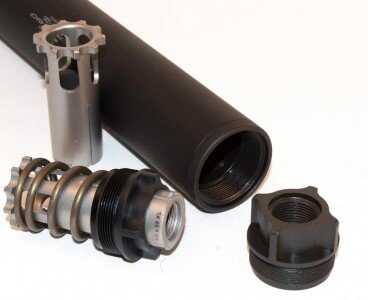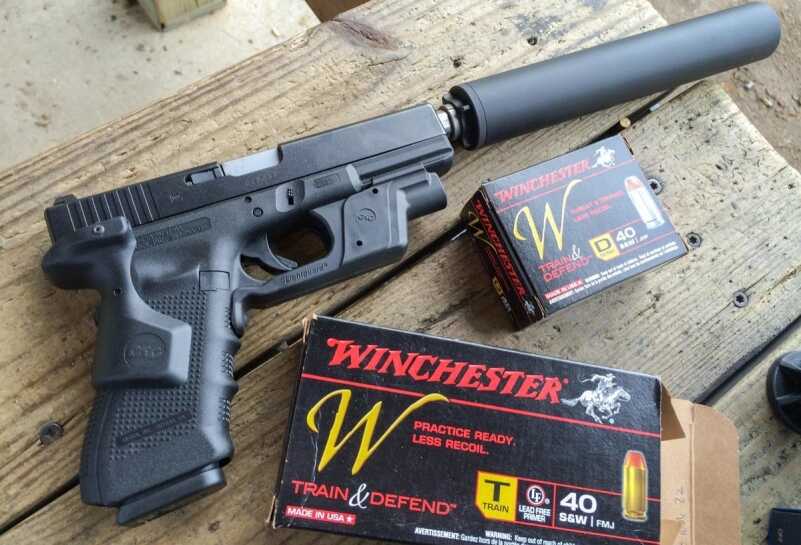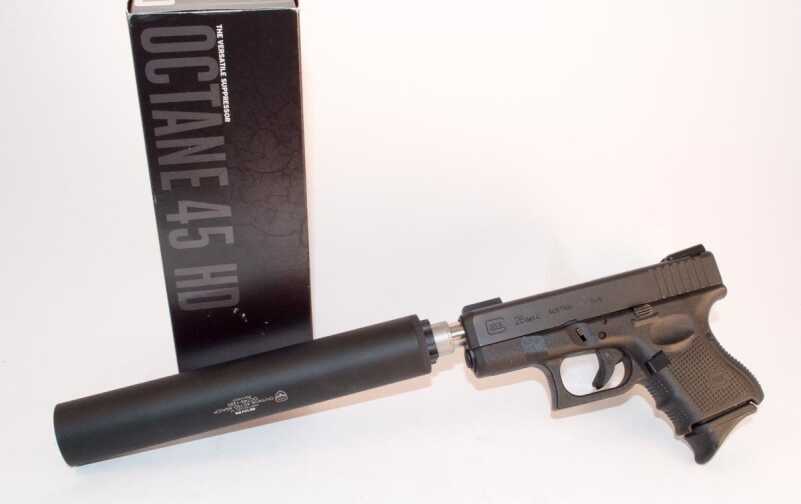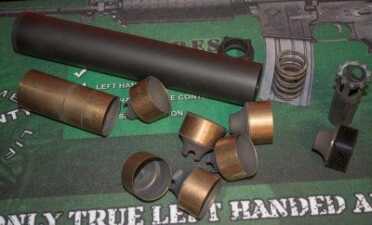When I bought a SilencerCo Octane 45 suppressor, there were two models available, a 9mm, and a .45 ACP. Now, the Octane is becoming a small family with the addition of the compact Octane K 45. More on that later.
Before you question the lack of a .40 S&W model, consider that there is really no need for a specific size for that caliber. Generally speaking, and assuming we remain in vaguely similar pressure ranges, you can use a larger caliber silencer with a smaller caliber bullet with very little disadvantage. For example, I bought the SilencerCo Octane 45 specifically, so I could use it with .45 ACP, .40 S&W, 9mm, .380 ACP and even some 300 AAC Blackout loads.
There are only two minor disadvantages to buying an ‘oversized’ silencer. First, it may be physically a bit larger than you need for a smaller caliber. You can take a look a the dimension differences between the Octane 45 and Octane 9mm to see what I mean.

Second, you will lose just a bit of noise suppression efficiency. For example, shooting the same 9mm from the Octane 45 will be a little more than 3 decibels louder than the same load from the 9mm Octane model. But even that is not a hard and fast data point. Sound is a complex thing, and the dB reading is only one component. Since the Octane 45 is larger, the tone is different. You may or may not be able to tell whether the 45 or 9mm model is “louder” when firing the same 9mm load through each.

Given all that, I opted to go with the Octane 45, knowingly accepting slightly larger size and an ounce+ more weight in return for flexibility. I’m glad I did, as so far I’ve used the Octane 45 with a Glock 26 9mm, Glock 22 .40 S&W, a Beretta 92FS 9mm, an FNX 45 Tactical and even two different 300 Blackout rifles with subsonic loads.
Let’s talk about that for a minute. The subsonic 300 Blackout loads are pretty mellow and operate at pistol-level pressures, so the Octane 45 is rated for that use. Don’t use it with supersonic 300 Blackout loads as pressures are far higher and the Octane is not rated for that. Since we’re talking about ratings here, know that you can also use the Octane suppressors with full auto guns in the supported calibers. Got an H&K MP5 or Kriss Vector and a garage full of ammo? No problem.
Reliable function
Part of the reason that the Octane works on so many platforms is the flexible mount design. It’s not just the size of the hole in front that you have to worry about, but the type of action the host gun uses.

Just replace the cylinder inside of the booster assembly to mount the Octane to different diameter barrels.
SilencerCo uses a “booster” to help retain reliable function on semi-automatic guns where the barrel moves as part of recoil. Think about something like a Beretta 92FS for a minute. It’s designed to allow the barrel to move backward upon recoil, so pressure can dissipate before it unlocks from the slide. This movement, unlock, ejection, loading and relocking sequence relies on a careful balance of cartridge pressure, mass of the parts involved and spring strength. When you add a 10 or 12 ounce suppressor to the barrel, the mass part of the equation is completely changed. The barrel now has to drag a lot more weight with it. You may, or may not, get reliable function.
The booster, in very simple terms, works like this: The silencer mounts to the threaded barrel with a spring assembly. The gas ejecting from the muzzle pushes the suppressor forward a bit, against spring pressure. As the gas leaves, the spring wants to regain it’s original position and moves the suppressor back towards the gun. This rearward motion of the suppressor coincides with the rearward motion of the barrel, so the barrel is not having to lug a lot of extra weight. If you hold a handgun with a booster-equipped suppressor and pull the gun and suppressor in opposite directions, you see what I mean.
All of that is a long explanation for saying that the SilencerCo Octane will most likely work just fine with your semi-automatic handgun. If you’re going to mount the Octane on a gun without a moving barrel, like a pistol carbine or 300 Blackout rifle or pistol, then you remove the booster and replace it with a fixed mount. If the barrel doesn’t move, you don’t want the silencer to move either.
Ammunition
One benefit of going with a larger caliber suppressor is that larger calibers are generally subsonic. A suppressor dramatically reduces the “blast” associated with hot gas leaving the muzzle at great speed. It does nothing to eliminate the tiny little sonic boom that a projectile traveling at supersonic speed creates. While the speed of sound varies with altitude and other factors, you might assume it’s somewhere in the 1,130 feet per second range in many lower elevation areas. If you use heavier bullets for .45 ACP and .40 S&W, most loads are going to generate less velocity than that, so you’ve got a pretty quiet setup. If you shoot 9mm, you can stick with 147 grain loads to remain subsonic.
Don’t get me wrong, supersonic loads are also much, much quieter when using a suppressor, but you’ll always get maximum suppression with a subsonic projectile.
Maintenance
Most rifle suppressors are self-contained and not user maintainable. That’s because the high-pressure hot gas of rifle loads are to a large degree, self-cleaning.You’re literally burning the suppressor clean, much like the way a self-cleaning oven works.
With a pistol suppressor, you’re going to want to clean things out periodically as lower pressures, and use of lead bullets is likely to leave some filthy crud in your silencer.
One of the things I like about the Octane is the way the guts come out for easy cleaning. Using the included tool, you remove the end cap and spill the internal baffles right out. As you can see from the photo, they’re a little bit like round metal Lego blocks. They “lock together” into a stack, which you slide into the suppressor body tube.
Cleaning is a breeze. You can soak the parts, brush them, or dump them in an ultrasonic cleaner. If you go ultrasonic, I would avoid putting the body and end caps in there as it might harm the nice exterior finish.
Closing thoughts
The most surprising thing about adding a pistol silencer to my collection is how it changes the whole feel of shooting. The sharp bangs turn to more of a whoosh. You can hear bullets zinging through the air. Recoil feels less abrupt. Newer shooters are less likely to flinch. Depending on your ammo selection, you may be able to remove hearing protection for shorter range sessions. Remember though, longer exposure to lower sound levels is harmful to your hearing too. Unless I’m only going to fire a couple of shots, I use hearing protection anyway. Better safe now than sorry later.

One hidden benefit to this configuration is that the Crimson Trace Lasergrips clear the suppressor body.
One more thing I should mention. The diameter of the cylindrical tube is perfectly compatible with Crimson Trace Lasergrips. That means that the beam on the gun, Lasergrip and Octane combinations I’ve tried thus far is not blocked by the suppressor body. So while most standard sights are at least partially blocked by the silencer, the beam still offers a viable sighting option. Be sure to verify this with your own configuration though as every gun and Lasergrip model combination is a little different.
Wait times on BATFE tax stamp applications are back down to more rational times like a month or two, so now’s the time to get your own. You won’t be sorry.
MSRP: $892, $840 for the K model.



I appreciate the informative information. I am in the “waiting” period for the exact same suppressor as reviewed. This is my first suppressor and I think for my first one, this will be a good, kind of multi purpose suppressor…..or at least I hope it will. I was planning on using this on my 1911, g23 and various 9mm and also a 300 BLK when I get an new upper. I know it won’t be “as good” of sound reductions on the lower calibers but I can buy specifically for those later, if I think I need to (which at about $1000 per, I doubt I will….maybe 9mm, it’s an addiction, lol). Honestly, the 22 LR suppressor will be next on my list. Thanks for the review. It makes me feel better about my big, not well thought out purchase.
Tom McHale wrote a good article about the Silencerco’s Octane Suppressor, but he is a little blase’ about reporting sound damage to the ear. “For example, shooting the same 9 mm from the Octane 45 will be a little more than 3dB louder than the same load from the 9 mm Octane model.” Pssst! 3dB represents a doubling of sound intensity!
The perceived loudness may not seem to be that severe but the actual intensity is. Ear damage results from the intensity of sound not the subjective loudness of sound.
Worse, ALL of the reported suppressed decibel levels that Mr. McHale included in his report are DEAFENING! Anything over 110dB damages the human ear. Even worse, such damage is additive over time. Each succeeding shooting event adds to the damage already done to your unprotected ears.
The biggest mistake that most people make about decibel levels is assuming that the decibel levels are linear, they are not. As I already noted, each 3dB increase in noise is TWICE as great as the reference level. Always use ear protection, even if it is the inexpensive ear inserts that are disposable.
I use a head set that has a microphone that “hears” the sounds and retransmits the same sounds to your ears at safe decibel levels. The neat thing about these devices is that you can hear normal conversation but you are protected from damaging sounds. When you fire a 264 Winchester Magnum, you only hear a very small report. If you try it without the head set, your ears hurt and you notice a ringing in your ears.
I don’t have any stock in the Howard Leight company but their “Impact Sport” headset is superb for shooting at a range where the guy next to you is firing a .375 H and H Magnum. Firearm sound suppressors keep the noise in the neighborhood down but they will not protect your ears from damage.
$900.00 can buy a lifetime supply of great earplugs.
Maybe if I were James Bond going on a covert mission and didn’t live in CA.
For a — no time to fiddle in the middle of the night — bedside/house gun, a silencer mated and requiring no time to install or fumble with in the dark makes sense. The gun in the picture appears to be a Gen 4 G19. I use a similar setup on a Gen 3 G19 except the light is brighter than the CT unit. Grab it in the dark and light, laser and suppressor are instantly in use, while still maintaining the ability to momentarily turn off the light to avoid giving away your position simply by relaxing your second finger on your gun hand grip. Firing a handgun inside a house without a suppressor is punishing in any caliber. Firing a handgun inside a house in time of crises without one might be the crucial difference in time of incapacitation of the threat, not to mention possibly saving ones hearing.
I can see that practicality.
I’m really against lights for the reason you mentioned. (I practice more in my dark house than anywhere.)
California has me not looking at them in the way you mentioned. Good reason.
I’m still a cheap skate and still have a few more firearms I want before I spend $900.00 on a silencer
I wouldn’t pay more than $200. for the sound conveniences even if I could.
The decibel numbers are correct. While “ear pain” is a subjective measure, most credible sources indicate “pain” begins at 130 or 140 decibels depending on which source. Of course, more exposure to lower levels is bad too.
Those decibels seem way off. Ear pain begins at 125 decibels.
Nor do they say where the microphone is.
Note: Speed of sound varies ONLY with temperature. 50,000 feet or sea level, same temperature gives same speed of sound. It is the definition of temperature – the kinetic energy of the gas molecules – which is related only to speed, and speed of sound is the speed of the gas molecules in the air. It is a common misconception, like some of the strange ideas about shooting uphill or downhill versus level.